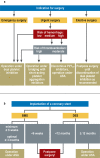The perioperative management of treatment with anticoagulants and platelet aggregation inhibitors
- PMID: 24069073
- PMCID: PMC3782019
- DOI: 10.3238/arztebl.2013.0525
The perioperative management of treatment with anticoagulants and platelet aggregation inhibitors
Abstract
Background: When giving anticoagulants and inhibitors of platelet aggregation either prophylactically or therapeutically, physicians face the challenge of protecting patients from thromboembolic events without inducing harmful bleeding. Especially in the perioperative period, the use of these drugs requires a carefully balanced evaluation of their risks and benefits. Moreover, the choice of drug is difficult, because many different substances have been approved for clinical use.
Method: We selectively searched for relevant publications that appeared from 2003 to February 2013, with particular consideration of the guidelines of the European Society of Cardiology, the Association of Scientific Medical Societies in Germany (AWMF), the American College of Cardiology, and the American Heart Association.
Results: Vitamin K antagonists (VKA), low molecular weight heparins, and fondaparinux are the established anticoagulants. The past few years have seen the introduction of orally administered selective inhibitors of the clotting factors IIa (dabigatran) and Xa (rivaroxaban, apixaban). The timing of perioperative interruption of anticoagulation is based on pharmacokinetic considerations rather than on evidence from clinical trials. Recent studies have shown that substituting short-acting anticoagulants for VKA before a procedure increases the risk of bleeding without lowering the risk of periprocedural thromboembolic events. The therapeutic spectrum of acetylsalicylic acid and clopidogrel has been broadened by the newer platelet aggregation inhibitors prasugrel and ticagrelor. Patients with drug eluting stents should be treated with dual platelet inhibition for 12 months because of the risk of in-stent thrombosis.
Conclusion: Anticoagulants and platelet aggregation inhibitors are commonly used drugs, but the evidence for their perioperative management is limited. The risks of thrombosis and of hemorrhage must be balanced against each other in the individual case. Anticoagulation need not be stopped for minor procedures.
Figures



Comment in
-
Anticoagulation in atrial fibrillation: NOAC's the word.Dtsch Arztebl Int. 2013 Aug;110(31-32):523-4. doi: 10.3238/arztebl.2013.0523. Dtsch Arztebl Int. 2013. PMID: 24069072 Free PMC article. No abstract available.
References
-
- Graham I, Atar D, Borch-Johnsen K, Boysen G, et al. European Society of Cardiology (ESC) Committee for Practice Guidelines (CPG). European guidelines on cardiovascular disease prevention in clinical practice: executive summary: Fourth Joint Task Force of the European Society of Cardiology and Other Societies on Cardiovascular Disease Prevention in Clinical Practice (Constituted by representatives of nine societies and by invited experts) Eur Heart J. 2007;28:2375–2414. - PubMed
-
- Lahtela H, Rubboli A, Schlitt A, et al. AFCAS. Heparin bridging vs. uninterrupted oral anticoagulation in patients with Atrial Fibrillation undergoing Coronary Artery Stenting. Results from the AFCAS registry. Circ J. 2012;76:1363–1368. - PubMed
-
- Camm AJ, Lip GYH, De Caterina R, et al. 2012 focussed update of the ESC guidelines for the management of atrial fibrillation. Eur Heart J. 2012;33:2719–2747. - PubMed
-
- Siegal D, Yudin J, Kaatz S, Douketis JD, Lim W, Spyropoulos AC. Periprocedural heparin bridging in patients receiving vitamin K antagonists: systematic review and meta-analysis of bleeding and thromboembolic rates. Circulation. 2012;126:1630–1639. - PubMed
-
- Pausieren von oralen Antikoagulanzien bei Vorhofflimmern ist risikoreich. Arzneimittelbrief. 2013;47:4–5.
Publication types
MeSH terms
Substances
LinkOut - more resources
Full Text Sources
Other Literature Sources
Medical
Miscellaneous

